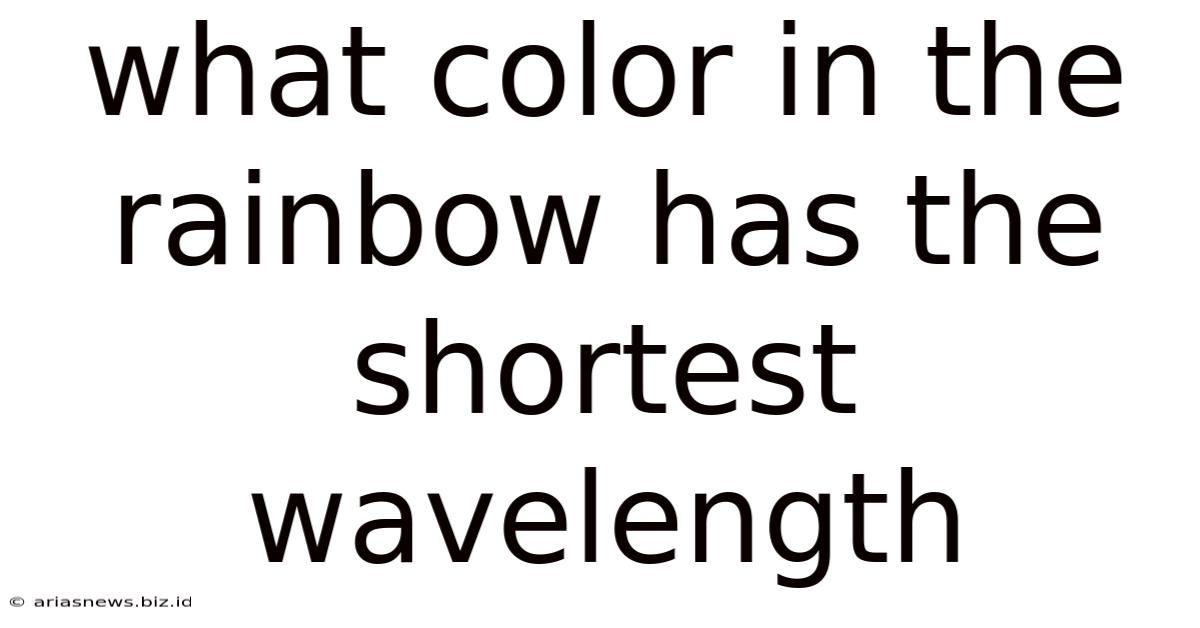What Color In The Rainbow Has The Shortest Wavelength
Arias News
May 11, 2025 · 4 min read

Table of Contents
What Color in the Rainbow Has the Shortest Wavelength?
The vibrant spectrum of a rainbow, a captivating natural phenomenon, is a testament to the wonders of light and its interaction with water droplets. But beyond its aesthetic beauty lies a fascinating scientific explanation rooted in the physics of light and its properties, specifically wavelength. This article delves into the question: what color in the rainbow has the shortest wavelength? We'll explore the electromagnetic spectrum, the nature of light, and the relationship between wavelength and color perception, ultimately revealing the color with the shortest wavelength in the visible spectrum.
Understanding the Electromagnetic Spectrum
Before we pinpoint the color with the shortest wavelength, it's crucial to understand the broader context – the electromagnetic spectrum. This spectrum encompasses all forms of electromagnetic radiation, arranged according to their wavelengths and frequencies. From the longest wavelengths to the shortest, the spectrum includes:
- Radio waves: Used in communication technologies, these waves possess the longest wavelengths.
- Microwaves: Used in ovens and radar systems, they have shorter wavelengths than radio waves.
- Infrared radiation: Experienced as heat, it's invisible to the human eye but detected by specialized sensors.
- Visible light: The only portion of the electromagnetic spectrum visible to the human eye, it forms the basis of our perception of color.
- Ultraviolet radiation: Invisible to the human eye but responsible for sunburns and vitamin D production.
- X-rays: Used in medical imaging due to their ability to penetrate soft tissues.
- Gamma rays: The highest energy and shortest wavelength radiation, often associated with nuclear processes.
Visible Light and Wavelength
Within the vast electromagnetic spectrum, visible light occupies a relatively narrow band. This visible light is what we perceive as color. The key to understanding color lies in the concept of wavelength. Wavelength is the distance between two consecutive crests or troughs of a light wave. Different wavelengths correspond to different colors.
Longer wavelengths are perceived as reds and oranges, while shorter wavelengths are perceived as blues and violets. This variation in wavelength is the fundamental reason why we see a rainbow of colors.
The Rainbow: A Spectrum of Colors
A rainbow is formed when sunlight interacts with water droplets in the atmosphere. Sunlight, which appears white to our eyes, is actually composed of all the colors of the visible spectrum. As sunlight enters a water droplet, it refracts (bends) due to the change in the refractive index between air and water. This bending separates the light into its constituent colors based on their different wavelengths. The colors then reflect internally within the droplet before refracting again as they exit, creating the spectacular arc we see.
Violet: The Color with the Shortest Wavelength
Based on the principles of light and its behavior, the answer is clear: violet has the shortest wavelength in the visible spectrum. This means that violet light waves have a higher frequency than other visible light colors. This higher frequency corresponds to a higher energy level.
Misconceptions about Indigo
Sometimes, indigo is mentioned as having a shorter wavelength than violet. However, this is a matter of debate and historical context. Newton originally identified seven colors in the spectrum, including indigo. However, many scientists now consider indigo to be a shade of blue or violet, rather than a distinct spectral color with its own unique wavelength range. In the modern scientific understanding of the visible spectrum, violet consistently holds the position of the color with the shortest wavelength.
The Importance of Wavelength in Various Fields
The concept of wavelength and its implications extend far beyond the simple appreciation of rainbows. Understanding the relationship between wavelength and color is fundamental in various fields:
- Optics: Wavelength is crucial in designing lenses, prisms, and other optical instruments.
- Spectroscopy: Analyzing the wavelengths of light emitted or absorbed by substances helps identify their composition. This is widely used in astronomy, chemistry, and environmental science.
- Photography: Different wavelengths of light affect the way images are captured and processed. Understanding this is crucial for proper color balance and exposure.
- Medicine: Various types of electromagnetic radiation, with different wavelengths, are used in medical treatments and diagnostics, including X-rays, ultraviolet therapy, and laser surgery.
- Communications: Different wavelengths are used for various communication technologies, like radio waves, microwaves, and fiber optics.
Conclusion: Violet Reigns Supreme
To reiterate, violet holds the title of possessing the shortest wavelength in the visible spectrum. This fact underlies the formation of rainbows and plays a crucial role in various scientific and technological applications. While the beauty of a rainbow is a visual delight, its underlying physics reveals a deeper understanding of light and its properties, highlighting the significant role of wavelength in shaping our world. Further exploration into the intricacies of light and the electromagnetic spectrum promises a deeper appreciation of the universe and its captivating phenomena. Remember, the next time you witness a rainbow, appreciate not just its beauty but also the scientific marvel that gives rise to its vibrant colors, with violet proudly leading the way with its remarkably short wavelength.
Latest Posts
Latest Posts
-
What Is The Greatest Common Factor Of 32 And 54
May 11, 2025
-
What Does It Mean When Someone Calls You Sweetheart
May 11, 2025
-
Facts About The Mountains And Basins Region Of Texas
May 11, 2025
-
What Is The 10 Percent Of 500
May 11, 2025
-
Highest Common Factor Of 24 And 56
May 11, 2025
Related Post
Thank you for visiting our website which covers about What Color In The Rainbow Has The Shortest Wavelength . We hope the information provided has been useful to you. Feel free to contact us if you have any questions or need further assistance. See you next time and don't miss to bookmark.